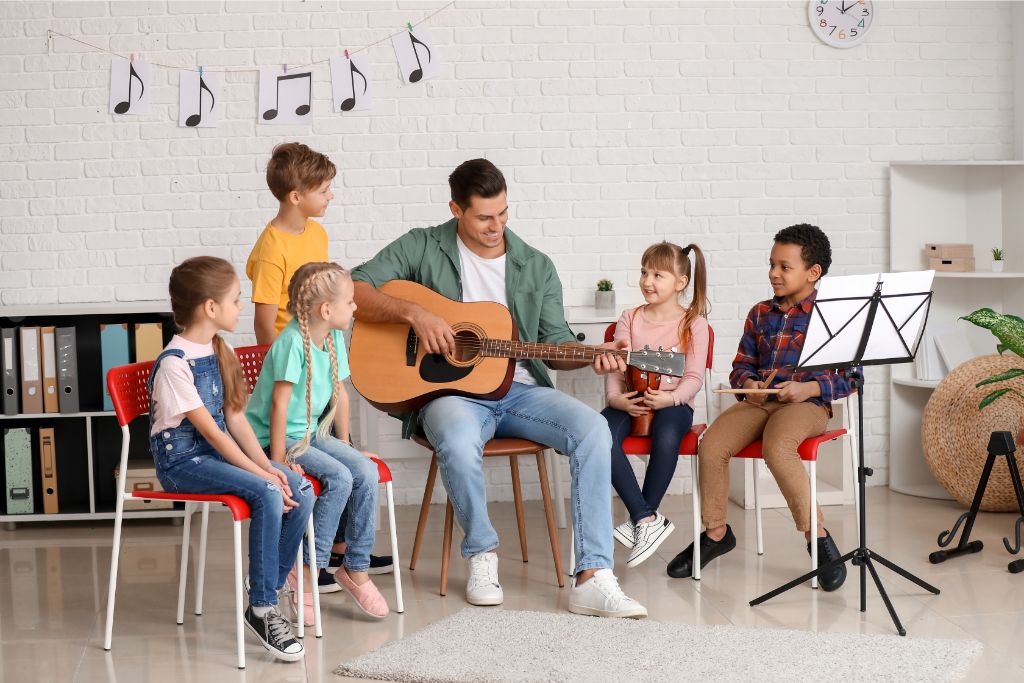You’re an incredible music maestro, yet finding new learners feels like a battle. You have the prowess, so what’s the gap? It’s time for social media magic! With the right maneuvers, your brand won’t just shine brighter. It will also resonate with potential learners. Ready to power up your music teaching venture through intelligent social media engagement? Let’s explore!
- Make your brand visible: Use social media to showcase your talent. Post videos of your performances or teaching sessions. Highlight your students’ progress. This will not only create interest but also help establish your credibility.
- Connect with potential students: Engage with your audience. Respond to comments, answer queries, and appreciate compliments. This interaction can build a community around your brand and attract new students.
- Share your passion for music: Show your love for music. Share posts about your favorite artists, songs, or instruments. This can help you connect with students who share similar tastes.
- Offer exclusive content: Provide value to your followers. Share exclusive content like music lessons, tips, or behind-the-scenes footage. This can make your followers feel special and keep them engaged with your brand.
Remember, social media is not just about promotion. It’s a tool for connection. Use it wisely, and watch your music teaching business grow!
Table of Contents
- 1 Understanding Your Audience
- 2 Choosing the Right Platforms
- 3 Creating Quality Content
- 4 Engaging with Your Audience
- 5 Using Social Media Ads
- 6 Collaborating with Other Music Teachers
- 7 Monitoring Your Progress
- 8 Maintaining Consistency
- 9 BONUS
- 10 Frequently Asked Questions
- 10.1 How can I protect my online teaching material from copyright infringement?
- 10.2 What is the best way to handle negative comments or reviews on social media?
- 10.3 How can I effectively use social media to network with music professionals and influencers?
- 10.4 How can I ensure privacy and safety while online promoting my music teaching business?
- 10.5 What should I do if my social media account is hacked or compromised?
Understanding Your Audience

You’ve got to understand who your audience is if you successfully boost your music teaching business through social media. Delving into audience demographics and interests is crucial to effectively tailor your content and marketing strategies.
Let’s start with the basics: age, location, gender, and occupation – these are fundamental aspects of demographic data that’ll guide you in shaping your social media presence. Say, for instance, if a significant portion of your audience comprises teenagers from the US who are passionate about pop music, you’d want to create more interactive and dynamic content that resonates with them.
Moreover, understanding their interests is equally critical. Are they looking for basic piano lessons or advanced guitar tutorials? Do they prefer classical tunes, or are they into modern beats? Analyzing what types of posts generate the most engagement or what music trends stimulate their excitement can enlighten you about their preferences.
Remember this, though – it’s not just about selling lessons; it’s about creating an engaging community on platforms like Instagram or Facebook where both budding musicians and seasoned artists find value in your offerings. Your success in boosting business will mirror how well you know and cater to your audience’s wants and needs.
Choosing the Right Platforms

Selecting the appropriate social platforms that will best reach potential students is crucial. Each platform has its algorithms and targeted demographics, making some more suitable than others depending on your teaching style and the type of students you aim to attract.
Consider these factors when choosing your platforms:
- Platform Algorithms:
- Facebook prioritizes content from friends and family but also values engagement, so active discussions on your posts can boost visibility.
- Instagram rewards consistency with higher post visibility. Utilize stories for daily updates without cluttering your feed.
- YouTube is great for long-form videos like tutorials or performances; it favors watch time in its algorithm.
- Targeted Demographics:
- Twitter has a younger demographic ideal if you’re targeting high school or college-aged students.
- LinkedIn caters to professionals interested in private lessons or corporate workshops.
Research each platform thoroughly and analyze how their algorithms and demographics align with your business strategy. Remember, it’s not about being everywhere at once but maximizing your impact where it counts most. By understanding what each platform offers, you can increase student engagement effectively.
Creating Quality Content

You’re already ahead of the curve, having identified the right social media platforms to boost your music teaching business.
Now, let’s dive into creating quality content that resonates with your audience and positions you as a thought leader in your field.
Sharing Music Lessons and Tips
Sharing music lessons and tips on social media can boost your visibility and attract potential students. It’s an effective way to showcase your expertise, engage with followers, and build a reputation in the industry. You could even organize Digital Recitals or Virtual Concerts, which are increasingly popular amidst current trends.
Here’s a quick guide:
| Platform | Tips | Example |
|---|---|---|
| Share short video tutorials | ‘How to tune a guitar | |
| Post snippets of student performances | ‘John’s first piano recital’ | |
| YouTube | Upload longer comprehensive lessons | ‘Learn Beethoven’s Moonlight Sonata: Part 1’ |
| Share music-related news & tips | ‘5 ways to improve pitch control’ | |
| TikTok | Create fun, engaging music challenges | ‘#BeginnerGuitarChallenge’ |
Showcasing Student Achievements
Highlighting student achievements on various platforms motivates them and showcases the effectiveness of your teaching methods. It’s a great way to celebrate progress and attract new students.
- Instagram: Post photos of students with their awards or during performances. Include their testimonials as captions.
- Facebook: Share videos of recitals showcasing student accomplishments. Use Facebook Live for a real-time experience.
- Twitter: Tweet about student milestones and retweet their music-related posts.
- YouTube: Upload well-edited videos from concerts or lessons demonstrating progress over time.
Engaging with Your Audience

You’ve established your social media presence and consistently produce quality content. But how do you actively engage with your audience to further boost your music teaching business?
Engaging doesn’t just mean posting; it’s also about responding promptly to comments and messages. Creating a two-way conversation fosters a sense of community.
Additionally, hosting live Q&A sessions can be an effective marketing strategy. It allows you to showcase your expertise in real-time, answer questions directly from potential students or parents, and keep up with the latest trends in the music industry.
Responding to Comments and Messages
It’s essential to promptly and thoughtfully respond to comments and messages on social media to build a strong rapport with potential students. Your comment etiquette should reflect professionalism, friendliness, and expertise. Message personalization is key – it shows you’re engaged and invested in their musical journey.
Here’s a handy guide:
| Platform | Comment Etiquette | Message Personalization |
|---|---|---|
| Be professional yet friendly in your responses. | Use the student’s first name and refer to specific posts. | |
| Keep it light-hearted but informative. Use emojis! | Mention something from the student’s profile that caught your attention. | |
| Be concise but engaging; make use of hashtags wisely. | Play along with the tweet they responded to or mention a relevant trend. | |
| Maintain a formal tone while being supportive. | Refer to their professional background or shared interests. | |
| YouTube | Appreciate positive feedback; address questions/queries. | Incorporate details from the video they commented on. |
Hosting Live Q&A Sessions
Hosting live Q&A sessions can be a great way to interact with your potential students and answer their queries in real time. By streamlining Q&A logistics, you’re not only saving time but also ensuring a well-organized session. Use social media platforms like Instagram or Facebook Live for these interactions; they’re user-friendly and popular among the younger demographic.
Incorporating interactive session formats is key. You could have impromptu performance reviews, discuss music industry trends, or demo new teaching techniques. This keeps the conversation engaging and relevant.
Always remember it’s crucial to promote these sessions ahead of time on your profiles for maximum participation. It’s a brilliant strategy to boost visibility while showcasing your expertise as an educator in the music realm.
Using Social Media Ads
You’re no stranger to the power of social media in the music industry, and you understand that running ads on platforms like Facebook and Instagram can catapult your reach beyond your wildest dreams.
Whether promoting a new album or selling tickets for an upcoming concert, these platforms offer unparalleled opportunities to connect with fans and attract new ones.
Let’s delve into how you can maximize your presence and drive real results using Facebook and Instagram ads as part of your robust marketing strategy.
Running Facebook Ads
Running Facebook Ads can significantly increase your music teaching business’s visibility. You’re not just throwing cash into the wind; ad targeting strategies guide your ads to potential students genuinely interested in learning music. You’ll leverage demographic data, interests, and browsing habits to reach those most likely to sign up for lessons.
Budget optimization is another key aspect of running successful Facebook ads. You don’t need a massive budget to see results; it’s more about how you manage what you’ve got. Analyzing performance metrics will help you understand which ads provide the best returns, allowing you to funnel more resources into high-performing campaigns.
Running Instagram Ads
When it comes to Instagram ads, they’re a robust tool that can help expand your potential student base. This platform’s vast reach and visual-centric nature make it perfect for showcasing your music-teaching prowess.
Ad budgeting strategies: Don’t let a tight budget deter you. Start small, measure results, then scale up.
Ad creative inspiration: Use dynamic visuals of instruments or students thriving in lessons. Make it relatable and aspirational!
Promotion of unique selling points (USPs): Highlight what sets you apart from other tutors – your genre expertise or innovative teaching methods.
Remember, Instagram users are typically younger – target accordingly! And don’t forget to incorporate the right hashtags to increase visibility.
With these tips, you can hit all the right notes with your ad campaign!
Collaborating with Other Music Teachers
Engaging with other music teachers on social media fosters collaboration and sharing of resources. These teacher partnerships can significantly expand your network and increase the visibility of your services. By leveraging each other’s followers, you’re tapping into a new audience already interested in learning music.
It would be best if you considered cross-promotion strategies for maximum impact. For instance, host Instagram Live sessions together, where you both share insights or teach mini-lessons. Promote these sessions on both of your profiles to ensure maximum reach.
Additionally, conduct joint giveaways – these are proven to drive engagement and follower growth. You could also guest post on each other’s blogs or newsletters; this provides valuable content and drives traffic between your sites.
Remember, though. Collaborating with those who resonate with your teaching philosophy and style is essential. A mismatch can confuse your students and dilute your brand image.
Monitoring Your Progress
You’ll need to consistently track your growth and evaluate the effectiveness of your strategies to ensure you’re moving in the right direction. That’s where progress-tracking tools and performance analytics come into play. They provide valuable data on how well your social media campaigns are performing.
Consider this:
- Progress Tracking Tools
- Social Media Analytics: These tools measure engagement, reach, and follower growth.
- Website Analytics: Track how many visitors come from your social media platforms.
- Performance Analytics
- Audience Insights: Understand who engages with your posts – their age, location, interests, etc.
- Content Analysis: Identify which post types (video tutorials, music theory discussions) get the most engagement.
Stay current with music industry trends; knowing what’s hot helps you tailor content that resonates with potential students. Evaluate each campaign—Did it attract new students? Boost class sign-ups?
Remember, it’s not just about accumulating followers; it’s about converting them into paying customers. Make data-driven decisions based on these analytics. They’ll guide you in refining strategies that work for you—and ditching those that don’t.
Social media is a powerful tool—use it wisely to amplify your music teaching business!
Maintaining Consistency
Maintaining a consistent presence on your chosen platforms can increase engagement and foster stronger relationships with your audience. Consistency is key in the fast-moving digital world, especially regarding social media marketing for your music teaching business.
Part of maintaining that consistency involves scheduling posts. You can’t be online 24/7, and let’s face it, you’ve got lessons to prepare and students to teach. That’s why using tools like Hootsuite or Buffer can be a game-changer. Schedule engaging content ahead of time across multiple platforms, ensuring you’re always present even when you’re busy elsewhere.
Your branding strategy also plays a crucial role in maintaining consistency. Everything from your logo to your voice should reflect who you are as a music teacher. This helps potential students understand what to expect from your lessons – fun-filled sessions or intense conservatory-level training.
Watch out for trends within the music industry, such as virtual concerts or live Q&As – these could inspire fresh post ideas that keep followers engaged while staying true to your brand. Remember: In this ever-evolving social media landscape, it’s not just about being there – it’s about being reliable and relevant!
BONUS
Boost your music teaching business with OnlySocial’s essential Post Planning and Scheduling function. Seamlessly plan and schedule your posts across all social networks, ensuring consistent and strategic content delivery. With unlimited posting and the ability to manage unlimited social profiles, you can expand your online presence without limitations. Don’t miss out on optimizing your social media strategy. Sign up for a commitment-free 7-day trial today.
Frequently Asked Questions
How can I protect my online teaching material from copyright infringement?
Keep your online teaching material safe! How? By using digital watermarking. This sneaky method hides a traceable mark in your content. Plus, you can try content licensing. It helps you legally decide who can use and share your precious material.
What is the best way to handle negative comments or reviews on social media?
When dealing with harsh comments or trolls, use intelligent damage control. Answer promptly, with respect. Change criticism into productive conversation. Don’t remove bad feedback unless it’s rude. Honesty will strengthen trust with your online followers.
How can I effectively use social media to network with music professionals and influencers?
Begin by forming connections on platforms popular with music insiders. Join discussions, offer insightful posts, and show your support. Plan collaborations with influencers to increase your exposure. Make sure it’s a win-win situation.
How can I ensure privacy and safety while online promoting my music teaching business?
Take control of your privacy by fine-tuning your privacy settings on each platform. Remember your digital footprint; it’s crucial not to spill too many personal details. Have a clear boundary between business and personal life by maintaining separate profiles. This not only enhances your privacy but also bolsters your online safety.
What should I do if my social media account is hacked or compromised?
Oh no, your social media account got hacked? Don’t worry. Let’s sort this out. First up, change your passwords right away. You may use two-factor authentication as a recovery tactic. Remember, it’s crucial to reach out to platform support, too.
For the future, why not up your game? Try using strong and unique passwords. This way, you can avoid such nasty surprises in the future. Keep your accounts safe and secure!




